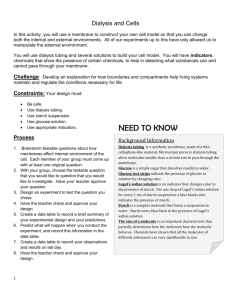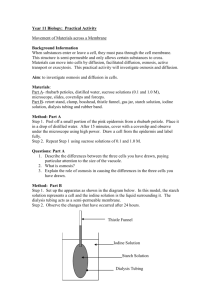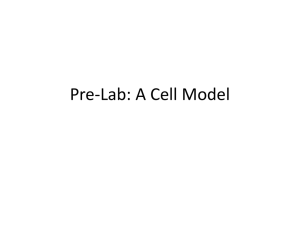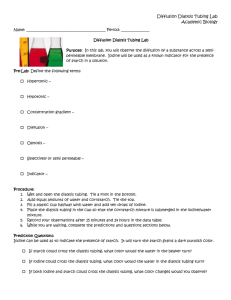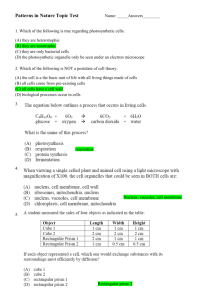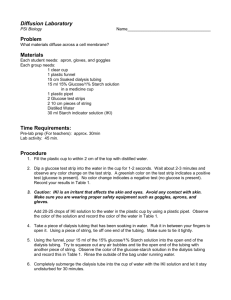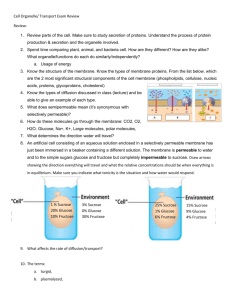Colligative Properties of Solution
advertisement
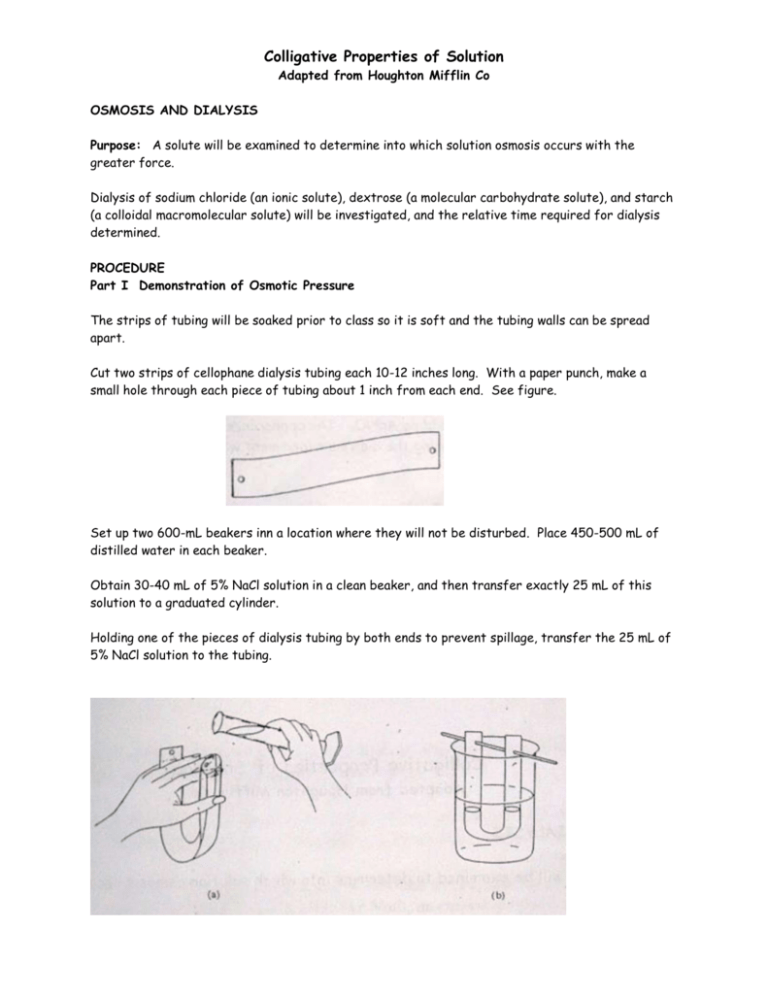
Colligative Properties of Solution Adapted from Houghton Mifflin Co OSMOSIS AND DIALYSIS Purpose: A solute will be examined to determine into which solution osmosis occurs with the greater force. Dialysis of sodium chloride (an ionic solute), dextrose (a molecular carbohydrate solute), and starch (a colloidal macromolecular solute) will be investigated, and the relative time required for dialysis determined. PROCEDURE Part I Demonstration of Osmotic Pressure The strips of tubing will be soaked prior to class so it is soft and the tubing walls can be spread apart. Cut two strips of cellophane dialysis tubing each 10-12 inches long. With a paper punch, make a small hole through each piece of tubing about 1 inch from each end. See figure. Set up two 600-mL beakers inn a location where they will not be disturbed. Place 450-500 mL of distilled water in each beaker. Obtain 30-40 mL of 5% NaCl solution in a clean beaker, and then transfer exactly 25 mL of this solution to a graduated cylinder. Holding one of the pieces of dialysis tubing by both ends to prevent spillage, transfer the 25 mL of 5% NaCl solution to the tubing. Insert a stirring rod through the holes in the end of the dialysis tubing, and suspend the tubing containing 5% NaCl solution in one of the beakers of distilled water. If the solution in the tubing is not covered by the water in the beaker, add additional water to the beaker. See figure below. Repeat the process using the second length of dialysis tubing and the other beaker, using 25% NaCl in place of the 5% solution. Allow the two beakers to stand for approximately one hour. At the end of this time, carefully determine the volume of the solutions in the dialysis tubing lengths by pouring the solutions separately into a graduated cylinder. Create a data table organizing the volume initial and final. Part II Dialaysis For the Indicator Test, obtain the 25% NaCl, 25% Dextrose, and 10% Starch Solutions. Using a spot plate, test for NaCl by adding AgNO3. The appearance of white precipitate of AgCl upon treatment with silver nitrate during the dialysis experiment will confirm the presence of chloride ion. To test for starch, use a spot plate. To a few drops of starch, add a few drops of I 2/KI reagent. The appearance of a blue-black color upon treatment with iodine reagent during the dialysis experiment will confirm the presence of starch. To test for dextrose, use a small test tube. Place a few mL of the dextrose solution into the test tube and then add approximately 5 mL of Benedict’s or Fehling’s reagent, and heat briefly in a boiling water bath. The appearance of a green or orange precipitate upon similar treatment will confirm the presence of dextrose during the dialysis. Create a data table organizing the observations for each test. Part III To test for the flow of these particles through the dialysis tubing, obtain a 10-12 inch length of dialysis tubing and punch a hole about 1 inch from either end. The tubing was soaked in water until the walls can be spread apart. Set up a 600-mL beaker containing 450-500 mL of distilled water in a place where the beaker will not be disturbed. Holding the dialysis tubing by both ends to prevent spillage, transfer approximately 10 mL of the 25 NaCl, 25% dextrose, and 10% starch solutions to the tubing. Insert a stirring rod through the holes in the dialysis tubing, and suspend the tubing in the beaker of distilled water. Add additional water if necessary to cover the solution in the dialysis tubing. Immediately after placing the dialysis tubing in the distilled water, remove approximately 3-4 mL of water from the beaker and perform the tests for NaCl, dextrose, and starch described earlier. At 5-minute intervals for the next hour, remove small portions of distilled water from the beaker and repeat the tests for the three solutes. Record all results in a well organized data table. Data Tables for all three parts need to be in every student’s graph paper book. Part I 5% NaCl compared to 25% NaCl Part II Results of Chemical test including present of Cl- ions, dextrose, or starch. Part III Time results for movement of particles across the dialysis membrane. You need to finish the lab report by including: Conclusion Statement: Discussion of Theory: Sources of Error (2): Questions: 1. Using a formula explain the reason for the results determined in Part I. 2. If the experiment was performed correctly, why is starch not detected in the water even after a full hour (why would it never be detected?) ?. What is different about a starch solution that causes this? 3. If red blood cells are placed in a solution which is not isotonic with the liquids inside the cells, the cells will undergo either hemolysis or crenation depending on the difference in concentrations. Explain why hemolysis occurs and what the solution composition would be. Then relate this to crenation and explain the opposite effect.

